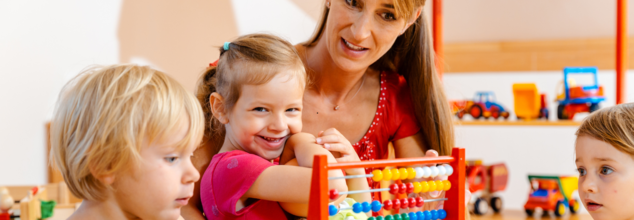- Health Conditions A-Z
- Health & Wellness
- Nutrition
- Fitness
- Health News
- Ayurveda
- Videos
- Medicine A-Z
- Parenting
- Web Stories
Lower Noise Levels Linked to Calmer Kids, Research Finds

Credits: Canva
As a kid, the first day at school could be really anxiety-inducing, an emotional rollercoaster, of course. From saying goodbye to a parent to navigating the unfamiliar sights and sounds, it could altogether be an overwhelming experience. However, could something as subtle as a ceiling design help?
A recent study suggests that improving acoustics in preschool classrooms—specifically by reducing noise—can have a calming effect on children and improve their ability to speak and listen.
The Impact of Sound on Preschoolers
The study, led by Ikuri Matsuoka, a master’s student at Kumamoto University in Japan, focused on how sound-absorbing ceilings influenced young children during indoor activities. The research was presented at a meeting of the Acoustical Society of America held in New Orleans.
According to Matsuoka, most classrooms in Japan lack any kind of sound-absorbing materials. “My motivation was to make people aware of the importance of acoustics in classrooms,” Matsuoka said. “In Japan, there are no standards or guidelines for acoustic design of preschool and school classrooms.”
This lack of attention to classroom acoustics can have a significant impact. Many preschoolers are still developing their language skills, and noisy or echo-filled environments can make it difficult for them to communicate effectively. Such conditions can also increase stress levels, leading to more frequent crying or even louder talking as children try to be heard.
A Sound Experiment
To explore the impact of soundproofing, Matsuoka and the research team installed polyester fiberboard—a sound-absorbing material—on the ceiling of one preschool classroom. They then compared this classroom with another that had no such acoustic enhancements.
Over six months, the team used video and audio recordings to track how loudly children spoke and how often they cried. Artificial intelligence (AI) and machine learning tools helped analyze the data without the need for constant manual observation.
The results were clear: children in the classroom without soundproofing were significantly louder. Teachers were also interviewed four times during the study. Three out of four noted a noticeable difference in sound quality. One veteran teacher with 25 years of experience even remarked that she felt more comfortable talking to children in the treated classroom.
A Call to Action
“Our research shows that reduced reverberation can mitigate noisy environments and promote clearer communication for children,” Matsuoka said.
The study offers a compelling case for educators, architects, and policymakers to consider acoustic design when planning learning environments for young children. While findings presented at conferences are considered preliminary until published in peer-reviewed journals, the research highlights an often-overlooked factor that could significantly improve preschool experiences.
In a world where early learning is increasingly emphasized, something as simple as a quieter classroom may play a key role in helping children thrive.
Experts Confirm 'Baby Brain' Is No Myth- 3 Surprising Ways It Impacts New Moms

Credits: Canva
For generations, “baby brain” has been a punchline—a casual explanation for forgetfulness, misplaced items, or that elusive word hanging just out of reach for new mothers. But what if there’s more truth to this phenomenon than we’ve ever acknowledged? Gratefully, with the aid of contemporary neuroscience and increasing scientific research, scientists are affirming what mothers have always intuited: "baby brain" isn't merely real, but is also a reflection of deep brain changes that start during pregnancy and extend after giving birth.
Science has long proven that the human brain is not fixed. By a process known as neuroplasticity, it reshapes itself constantly in response to great life events. For women, three such stages—puberty, pregnancy, and perimenopause—signal particularly dramatic episodes of brain transformation. But among all these life changes, none appears to produce more far-reaching rewiring than motherhood.
A new National Institute of Mental Health study by neuroscientist Dr. Pilyoung Kim employed MRI scans to take a close look at the brains of recently delivered mothers within days of giving birth and again several months later. In the resulting study published in Behavioral Neuroscience, measurable increases in gray matter volume in various brain regions seldom observed in adult neurodevelopment were found, including:
The hypothalamus, which is responsible for motivation in mothers.
- The amygdala and substantia nigra, which control emotion and reward processing.
- The parietal lobe, which manages sensory integration.
- The prefrontal cortex, the center of reason, decision-making, and judgment.
What's even more intriguing is that these changes were more intense in mothers who exhibited more enthusiasm and affection for their infants. Emotional bonding, in other words, may not only feel good—it could literally make a mother's brain better.
Three Unexpected Effects of "Mom Brain" on New Moms
1. Enhanced Emotional Sensitivity and Social Awareness
Forgetfulness aside, perhaps the most underestiamted phenomenon affecting "baby brain" is its possible positive side. According to new research, the shifts new mothers go through may actually increase their ability for emotional sensitivity, empathy, and social responsiveness.
Hormones such as oxytocin and prolactin—also referred to as the "bonding hormones"—increase during and following pregnancy, encouraging maternal behaviors and increasing attunement with the infant. This ensures mothers are better attuned to detecting subtleties such as a change in facial expression or voice tone—vital for caregiving and early infant maintenance.
Effectively, new mothers can potentially forgo multitasking skills in the short run in exchange for cultivating laser-sharp attention to their baby's needs. What constitutes perceived brain fog can actually be an adjustment in priorities and focus toward caregiving activities essential to a newborn's survival and emotional growth.
2. Structural Brain Development Associated with Learning and Attachment
The idea that a woman's brain "shrinks" following childbirth is a discredited and misleading concept. Actually, according to the study's implication, the maternal brain experiences beneficial structural development, specifically in gray matter—a concentrated form of brain tissue associated with learning, memory, and decision-making.
This expansion is thought to be driven not only by hormones, but by the intense sensory and emotional input of being with an infant. Each diaper change, feeding, cuddle, and lullaby provides input that remodels and strengthens maternal brain circuits.
It's also interesting to mention that all study participants were lactating mothers and none had postpartum depression. Researchers now investigate whether these two mechanisms—hormonal release and emotional management—are linked with neuroplastic modifications in the mother's brain.
3. Memory Failures Could Be Transient but Significant
Yes, "mom brain" will bring about genuine memory loss—such as tossing dirty laundry in the trash or forgetting where you parked the car—but these are fleeting and part of a greater neurological transformation. New mothers have a redirection of information prioritization, such that certain short-term memory processes are relegated to a secondary position while other cognitive processes become enhanced.
Experts believe such lapses may be a result of the brain reordering resources in order to pay attention to emotional management, caregiving actions, and heightened watchfulness over the safety of the baby. Consider it as a functional trade-off and not a decline in intellect.
Can You Prevent "Baby Brain"?
Though you can't stop the changes in your mother's brain—after all, they're engineered to accommodate the new mom role—you can do some things to cope with some of the more annoying side effects:
- Blaming self for memory lapses only creates more stress and mental haze.
- Keep lists, write reminders, and use phone reminders to assist with day-to-day tasks.
- Talk to other moms, that way, the isolation decreases and emotional support increases.
- Lack of sleep is a major contributor that can magnify memory problems.
- Rather than bemoan what you forgot, mark the small milestones your baby achieves daily.
Scientists are now gearing up to examine adoptive mothers to see if they can differentiate changes triggered by hormones from those triggered by the mere stimulation of caregiving. The question that remains the ultimate one is: Does the brain alter behavior—or does behavior alter the brain?
What is increasingly apparent, however, is that motherhood is not an intellectual dumbing-down. It's a cognitive transformation—a restructuring of the brain's circuitry to accommodate one of life's most challenging and rewarding jobs.
“Motherhood Takes a Lot Out of You” — Kalki Koechlin Opens Up About Pregnancy, Postpartum And Water Birthing

Credits: Instagram
Actor Kalki Koechlin has spoken candidly about the challenges of pregnancy and early motherhood, shedding light on a topic often brushed aside. After giving birth to her daughter Sappho in February 2020 with partner Guy Hershberg, the actor described the experience as both physically and emotionally draining.
“Your body is like a slave to another person. You’re just an incubation system,” Kalki shared, recalling how pregnancy, childbirth, and postpartum took a significant toll on her well-being. She spoke about feeling disoriented and emotionally lost during the first few months. “Where is my life? Who am I?” she remembered asking herself—words that resonate with many mothers navigating a dramatic shift in identity.
Sleepless Nights and Nutritional Struggles
Koechlin shared how the postpartum period was marked by sleepless nights and physical exhaustion. “The first six months were really tough. I had to stay up all night to feed her,” she said. The continuous cycle of night feeds, hormonal changes, and breastfeeding left her depleted and stressed.
She also pointed out that society often fails to acknowledge or support women during this period. While the baby becomes the focus, the mother’s needs—emotional, physical, and mental—are often sidelined. Kalki’s experience serves as a reminder that new mothers need care, too.
Water Birth Is Normal, Not A "Cult" Practice
Kalki and her partner chose a water birth for Sappho’s arrival—an experience she strongly advocates for. Speaking on Aleena Dissects, she said, “Water birthing is much easier on the body during natural birth. There’s so much research that it’s easier for the baby when it comes out because it was in the amniotic fluid already, so it’s not a big shock.”
She believes that water birthing should be more widely accepted and available. “I think this should be standard practice,” she said. But despite the benefits, many people still view it with suspicion. “They think it’s some weird cult or chudail practice,” she remarked, adding that lack of awareness and cost are also major barriers.
A Long Labour Hour
In an earlier Instagram post, Kalki shared the details of her 17-hour labour and thanked her doctors at Tulip Women’s Care for supporting her choice to have a natural water birth. “Even when I begged them to take the baby out anyway they could, they said no—you’ve come this far and you’re going to have your natural water birth. An hour later, Sappho was born.”
Through her honest reflections, Kalki Koechlin is breaking the silence around the physical, emotional, and social challenges of motherhood. Her story not only offers comfort to women going through similar journeys but also pushes for better awareness, empathy, and informed choices around birthing and postpartum care.
'I Am A Nutritionist- These Are 4 Diet Non-Negotiables For My Son's Health'

Credits: Canva
When it comes to raising children, few tasks and responsibilities seem more daunting and less achievable than getting them well-fed and well-nourished. From limiting picky eating to avoiding the allure of ultra-processed snacks, parents today have a daily conundrum: how to feed their children in a manner that sustains growth, builds immunity, and prepares them for health throughout life. But the reality is nutrition for kids is not all about keeping them away from junk. It's about intentionally assembling a diet that nourishes the brain, gut, physical energy, and emotional well-being. And in our uber-speedy world of screen time and sit-tie times, that is more important than ever.
Especially important for the early years when a child's brain is growing like mad, bones are accumulating density, and immune systems are forming. Childhood nutrition does more than fuel playground dashes or after-school games. It sets the foundation for how our children's minds and bodies will operate for decades to come. Proper intake of essential nutrients during early years lowers the risk of chronic disease later in life, such as obesity, diabetes, and cardiovascular diseases, according to the American Academy of Pediatrics.
One of the voices adding sense to this topic is Sakshi Lalwani—a clinical nutritionist with more than 231,000 followers on Instagram. She's also a committed mom, and this dual identity provides her with the practical expertise born of both science and life experience. In one of her much-admired Mother's Day posts, she set out her four non-negotiable rules for feeding her son. Underpinned by science, tradition, and life, these rules are more than a list—they're a code. Here's what she is committed to and why it's deserving of adoption worldwide.
1. Good Fats Are Non-Negotiable—They Feed the Brain
As adults, most of us have spent decades overcoming the fear of fats. But for kids, healthy fats aren't just safe—kids need them. In fact, kids need more fat proportionately than adults because growing brains consist of almost 60% fat. The Harvard School of Public Health says that proper fat consumption in children is directly linked to optimal brain development, hormone function, and energy metabolism.
Lalwani makes good fats a top priority in her son's daily meals. "He has ghee, nut butters, and avocados on his daily plate," she reports. These are whole, intact sources of saturated and monounsaturated fats that not only provide nutrients but also facilitate the absorption of fat-soluble vitamins A, D, E, and K. Ghee, specifically—a common Indian kitchen staple—is high in butyrate, which aids the gut and inflammation regulation. Nut butters provide a tasty delivery system for protein and healthy fat, and avocados deliver fiber, folate, and potassium, a triad of benefits for developing bodies.
2. Iron & Zinc: Micronutrients With Macro Impact
Two minerals that tend to fly under the radar—but are central to children's health—are iron and zinc. Iron is necessary for transporting oxygen in the blood, and even mild deficiencies can cause fatigue, poor concentration, and slowed development. Zinc, meanwhile, is essential for immune function, cell growth, and even taste.
Even slight deficiencies impact concentration, immunity, and growth," Lalwani says, noting that she always adds soaked raisins, lentils, and pumpkin seeds to her son's diet. These foods provide plant-based forms of iron and zinc, which, when combined with vitamin C-rich fruit such as oranges or tomatoes, are easier for the body to absorb. Lentils are also a great source of protein and fiber, so they're a potent dietary ally when it comes to children's growth and digestive health.
Adding these minerals to your diet each day is easy enough: sprinkle pumpkin seeds on top of yogurt, add lentils to a soup, or provide soaked raisins as a snack following school. The important thing, experts say, is simplicity over consistency.
3. Gut Health Is the Silent Architect of Wellness
The saying "all health begins in the gut" is more than a wellness buzzphrase. Emerging research in pediatric nutrition shows that a healthy gut microbiome is linked to improved mood regulation, cognitive function, immune defense, and nutrient absorption. It’s no surprise, then, that gut health is one of Lalwani’s cornerstones.
“A healthy gut supports better mood, focus, and digestion,” she notes. To those ends, she incorporates foods such as curd (yogurt), bananas, garlic, and oats into her family's diet on a regular basis. Yogurt gives us probiotics, the good bacteria that ensure a balance of gut flora. Bananas are full of prebiotics—food for the good bacteria—while garlic contains antimicrobial activity and immune benefits. Oats not only have fiber to control digestion but also encourage the development of good bacteria in the colon.
Promoting a rich microbiome from birth has health benefits throughout life, such as lower allergy, eczema, and autoimmune disease risk. For parents, it can start easily—with a probiotic yogurt breakfast or banana-oat smoothie.
4. Early Habits Build Lifelong Wellness
The final pillar in Lalwani’s approach is perhaps the most holistic: building habits now that set the stage for the future. “What he eats now shapes his future metabolism, immunity, and eating habits,” she shares. Nutrition during the early years doesn't just fill tummies—it wires preferences, cravings, and emotional relationships with food.
She also stresses daily sun exposure and soaked almonds, both of which enhance the uptake of vital vitamins and minerals such as Vitamin D and magnesium. Sunlight still stands as the best and the most natural way of obtaining Vitamin D, essential to bone function and immunity. Almonds, when soaked, are easier to assimilate and are a very effective source of magnesium, a mineral that plays a role in more than 300 enzymatic processes in the body.
Establishing these routines early—eating whole foods, enjoying family meals, and spending time outdoors—can create positive associations around health that carry into adulthood.
Sakshi Lalwani’s food philosophy for her son is a timely reminder that children’s diets deserve as much attention and intention as any other aspect of parenting. Her four non-negotiables are more than just nutrition rules—they are a blueprint for nurturing resilient, well-rounded, and thriving individuals.
© 2024 Bennett, Coleman & Company Limited

